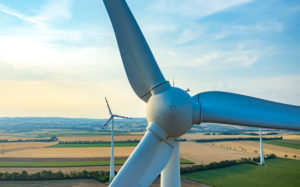Why Withdrawing from Paris is a Monumental Mistake
Last Thursday, the Trump administration officially announced that the United States would withdraw from the historic Paris agreement—a commitment of nearly every country in the world to reduce their greenhouse gas emissions and which aims to keep the planet’s warming below 2 degrees Celsius.
This withdrawal is a monumental mistake, and represents a complete disregard for three clear facts:
- Innovation in clean technologies—and jobs—is growing;
- Investing in growing clean energy, clean vehicles, and energy efficiency can drive manufacturing growth in the United States; and
- Failing to capitalize on the huge potential of the clean economy puts America at a competitive disadvantage—leaving these benefits for countries like China instead.
Rather than withdrawing from the agreement, the United States should instead lead the world in driving the significant economic growth and job creation that comes from designing, manufacturing, and installing the clean economy.
The Clean Economy Is Growing… And So Are Jobs

America is currently meeting the challenge of making our energy, transportation, and other systems cleaner and more efficient. We have already begun putting millions of people to work in jobs designing, manufacturing, and installing the clean energy technology and infrastructure needed to reduce the pollution that is driving climate change.
The U.S. Department of Energy (DOE) reports that installed renewable energy capacity increased more than 115 percent from 2000 to 2015, and now produces 14 percent of domestic electricity in the country. According to 2017 data recently released by the DOE in its second annual U.S. Energy and Employment Report, no- and low-carbon energy and energy and vehicle efficiency industries currently support approximately 4.5 million American jobs, including:
- 2 million jobs in energy efficiency;
- Almost 374,000 jobs in solar energy;
- Over 700,000 jobs working with fuel efficient and alternative vehicles and their components;
- 102,000 jobs in wind energy; and
- 19,745 jobs in smart grid technology.
And these are growing industries: in 2016, the solar workforce increased by 25 percent and wind employment increased by 32 percent, while the energy efficiency sector added 133,000 jobs, and expects to grow another 9 percent in 2017. The Solar Foundation Solar Job Census reported solar jobs have nearly tripled since 2010. The American Wind Energy Association estimated that 248,000 workers will have jobs in or supporting the wind industry by 2020.
Building on these investments by leading globally in growing the clean economy would mean more of these kinds of jobs here in the United States, and it’s critical that we spend our time working to ensure that existing jobs and those to come are quality, family-sustaining jobs in communities across the country. .
Manufacturing Job Growth
 We can capture even more of the economic benefits of these growing industries in our industrial and manufacturing sectors by ensuring that we’re not only installing these technologies, but manufacturing their component parts here at home.
We can capture even more of the economic benefits of these growing industries in our industrial and manufacturing sectors by ensuring that we’re not only installing these technologies, but manufacturing their component parts here at home.
The wind energy supply chain in 2009 was about 50 percent domestic content and about 240 facilities in the U.S. supplied the wind industry, employing 18,500 workers. By 2015, there were more than 500 manufacturing facilities in 43 states employing 21,000 workers, and domestic content had grown to 60 percent overall, and upwards of 80 percent for nacelle assembly and towers and between 50-70 percent for blades and hubs.
Leading the world in the clean technologies that will drive and power our future would mean more jobs in American manufacturing.
Losing our Competitive Edge—to China
While continuing to drive investments in these industries in the United States would mean more good jobs across the country, abandoning our leadership, on the other hand, risks relinquishing this opportunity.
The Paris agreement begins a process of holding all countries accountable for their emissions, which notably includes our global manufacturing competitors. Stepping away from the climate fight—and the investments in clean energy that result—will mean that the technologies of the future won’t be made here in America.
The international community has made clear that they are not slowing down. The EU and China are already pledging deeper cooperation on the Paris climate agreement and promoting clean energy technologies. China is building out wind faster than any other country. For example, 42.7 percent of new wind capacity installed globally in 2016 was in China, adding 23.4 gigawatts (GW) of Chinese wind compared to 8.3 GW in the United States. Fleeing from this agreement cedes the economic potential of a clean economy to those who will lead, like China and the European Union.
We’ve seen how strong and common sense policies that reduce emissions—and play a central role in meeting our climate commitments—drive job growth in forward-looking and global industries. For example, our report Supplying Ingenuity II: U.S. Suppliers of Key Clean, Fuel-Efficient Vehicle Technologies tells the story of how fuel efficiency standards boosted innovation in the auto industry, aiding in the industry’s recovery. Today 288,000 American workers are making the advanced automotive materials and components that go into improving vehicle efficiency in more than 1,200 U.S. factories and engineering facilities in 48 states.
How did this happen? U.S. companies invested in innovation and manufacturing and figured out how to meet strong standards, and in doing so, they are saving energy and reducing emissions while also saving consumers money. Furthermore, these innovative solutions generated advanced technologies and materials, improving the competitiveness of these companies in a global trade-exposed industry.
Whether we’re building cars or solar panels, more jobs and greater economic benefits are created by leadership investing in and manufacturing the technologies of tomorrow.
Transitioning to a Clean Energy Economy
 American leadership is key to providing a long-term market signal for governments, NGOs, and companies interested in investing in clean technology, efficiency improvements, carbon offsets, and other innovative ways to reduce emissions in the United States. That’s why the presidents of the AFL-CIO and the United Steelworkers—North America’s largest manufacturing union—expressed grave concerns about this decision’s impact on jobs, and more than 214 investors urged President Trump to uphold the Paris agreement, citing concerns about safeguarding their long-term investments. Hundreds of U.S. companies also urged him not to withdraw from the Paris agreement, arguing that it’s good for business. Governors of 12 states even sent a letter urging the President to remain in the agreement, citing—among issues like climate impacts already being experienced in their states and expected costs of future climate impacts—increasing economic opportunity and competitive advantage in growing global industries.
American leadership is key to providing a long-term market signal for governments, NGOs, and companies interested in investing in clean technology, efficiency improvements, carbon offsets, and other innovative ways to reduce emissions in the United States. That’s why the presidents of the AFL-CIO and the United Steelworkers—North America’s largest manufacturing union—expressed grave concerns about this decision’s impact on jobs, and more than 214 investors urged President Trump to uphold the Paris agreement, citing concerns about safeguarding their long-term investments. Hundreds of U.S. companies also urged him not to withdraw from the Paris agreement, arguing that it’s good for business. Governors of 12 states even sent a letter urging the President to remain in the agreement, citing—among issues like climate impacts already being experienced in their states and expected costs of future climate impacts—increasing economic opportunity and competitive advantage in growing global industries.
Leadership in innovation, investment, and manufacturing to meet domestic market demand helps boost competitiveness and leadership globally. In withdrawing, the United States from the Paris agreement, President Trump is ignoring these voices and putting American companies and manufacturers at a competitive disadvantage, thereby ceding this job-creating potential to countries like China.
The United States can and should lead the world in driving the significant economic growth and job creation that comes from designing, manufacturing, and installing the clean energy economy. But at the same time, we must ensure that the jobs we’re building in new clean technologies are quality, family-sustaining jobs and ensure that no communities or workers are left behind by the transition. Making available the tools and resources needed for workers to transition to new, good jobs and for communities to diversify their local and regional economies and create new opportunities is essential to the future of the clean economy.
Ultimately, we have everything we need to meet our commitment made in the Paris agreement. American innovation has the potential to lead the world in solving our environmental problems while creating good jobs for workers in the industries of our future.
We, as a nation, must recognize this opportunity and do what’s right for American workers, communities, and the planet.